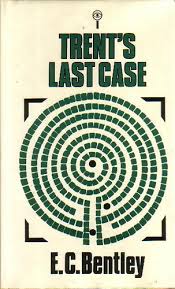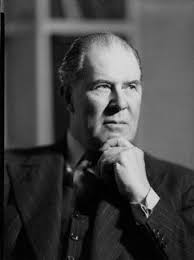The book was written on a dare.
The author was a British newspaper reporter named E.C. Bentley, and when his friend G.K. Chesterton (of Father Brown fame) challenged him to write a story about a new kind of detective–an antithesis to Sherlock Holmes–he complied. Bentley wanted his sleuth to be a realistic character, not an idiosyncratic mix of mannerisms. His detective would not be an analytical master of deduction. On the contrary, he would be so fallible that he might actually get the crime’s solution wrong. As Bentley explained in his 1905 autobiography, Those Days,
It should be possible, I thought, to write a detective story in which the detective was recognizable as a human being and was not quite so much the ‘heavy sleuth.’ … Why not show up the fallibility of the Holmesian method?
Bentley met Chesterson’s challenge, and the result was Trent’s Last Case, first published in 1913. The novel was wildly popular; in Britain, it sold out four editions in its first five months. In the United States, it was published as The Woman in Black and performed well. And over the years, both critics and mystery writers have offered generous praise of the book, with many even citing it as the first modern detective novel.
Here are the blurbs printed in the 1978 Perennial Library edition:
“One of the three best detective stories ever written.”–Agatha ChristieAnd in the same edition’s introduction, Dorothy L. Sayers wrote that Trent’s Last Case was “startlingly original … when it first appeared. It shook the little world of the mystery novel like a revolution, and nothing was ever quite the same again. Every detective writer of today owes something, consciously or unconsciously, to its liberating and inspiring influence.”
E.C. Bentley
Trent’s Last Case is far from a perfect crime novel. Modern readers may be unaccustomed to its flowery Edwardian language and slower pacing. In addition, the prejudices of Bentley’s era are present in the story: the racism, sexism, and anti-Semitism, in particular. Putting aside those historical markers, however, there’s much to enjoy and appreciate about the book–particularly in the character of “gentleman sleuth” Philip Trent and the plot’s triple twist of an ending.
“The finest detective story of modern times.”–G.K. Chesterton
After Sigsbee Manderson, a financial magnate, is found murdered on the grounds of his English country estate, Trent is called in to investigate. He is an artist who freelances as a newspaper reporter; in fact, he’s gained a reputation for publishing solutions to tough criminal cases that baffle the police. The Manderson murder case promises to be difficult: the victim was found shot through the eye with bruising on his wrists, indicating a struggle; his odd appearance suggests he dressed in haste, not even taking time to put in his dentures; and there are numerous suspects. They include his wife, Mabel (who was unhappy in her marriage), her uncle (who had quarreled with the victim), several servants, and a number of jealous business associates. As Trent puts it: “Here’s a man suddenly and violently killed, and nobody’s heart seems to be broken about it, to say the least.” Trent solves the case in three days–or so he believes. But he withholds the solution because of an unusual complication: he has fallen deeply in love with Mrs. Manderson, the dead man’s widow. Though his motivation for keeping the solution to himself is deeply personal–he wants only to protect Mabel–it leads to a fortunate result. Trent had gotten it wrong, and his “solution” would have doomed an innocent man to the hangman’s noose.
 Yes, Trent is fallible. And yes, his weakness in falling in love with a prime suspect is a device that is later borrowed with great success by future crime novelists and filmmakers. But the protagonist’s appeal also lies in his unique gift of perception. In that, Trent is different from–but not wholly unrelated to–his antithesis, Sherlock Holmes. In explaining why his own analysis succeeds, Holmes tells Watson: “You see, but you do not observe.” Trent is an artist, and he observes his case with an artist’s perceptive eye. As he tells it, what’s needed to find out the truth is a “delicacy of perception”:
Yes, Trent is fallible. And yes, his weakness in falling in love with a prime suspect is a device that is later borrowed with great success by future crime novelists and filmmakers. But the protagonist’s appeal also lies in his unique gift of perception. In that, Trent is different from–but not wholly unrelated to–his antithesis, Sherlock Holmes. In explaining why his own analysis succeeds, Holmes tells Watson: “You see, but you do not observe.” Trent is an artist, and he observes his case with an artist’s perceptive eye. As he tells it, what’s needed to find out the truth is a “delicacy of perception”:
The law certainly does not shine when it comes to a case requiring much delicacy of perception. … [W]hat would twelve red-faced realities in a jury-box have done to [young John] Marlowe? His story would, as he says, have been a great deal worse than no defence at all. It’s not as if there were a single piece of evidence in support of his tale.
This novel’s other strength is its clever plot, filled with enough twists to astonish and satisfy even today’s mystery fiction fans. Even as evidence builds that the victim himself played some role in his own demise, the final twist takes Trent (and likely the reader) by complete surprise. The real murderer confesses to Trent during the course of a celebratory dinner, secure in his belief that no legal consequences will follow. Based on the circumstances of the murder–and Trent’s own opinion of the killer–there is no question of involving forces of the law. Both Trent and the killer believe private justice has already been done.
Trent merely tells the man:
… I am cured. I will never touch a crime-mystery again. The Manderson affair shall be Philip Trent’s last case. …” Trent’s smile suddenly returned. “I could have borne everything but that last revelation of the impotence of human reason. … I have absolutely nothing left to say, except this: you have beaten me. I drink your health in a spirit of self-abasement. And you shall pay for the dinner.
With its unique detective figure and complex plot, Trent’s Last Case stands the test of time–and may even change the way existing fans of Golden Age classics view their favorite novels.
* * *
End note: Trent’s Last Case was not, in fact, his last case. E.C. Bentley eventually wrote more about Philip Trent, but not until 1936 when Trent’s Own Case was published, followed by Trent Intervenes in 1938. In the meantime, he penned and published several collections of clerihews (a type of short, comic biographical poem that he also invented).
***
References
Bentley, E. C. Trent’s Last Case. San Diego : University Extension, University of California, San Diego, c1977., 1977.
The Mystery library: 5.
Dorothy L. Sayers to E.C. Bentley, 17 April 1936, in The Letters of Dorothy L. Sayers, Vol. I, 1899–1936: The Making
of a Detective Novelist, ed. Barbara Reynolds (London: Hodder & Stoughton, 1995), pp. 387–8
Grella, George. “Murder and Manners: The Formal Detective Novel.” NOVEL: A Forum on Fiction, vol. 4, no. 1, 1970,
pp. 30–48. JSTOR
Howard Haycraft, Murder for Pleasure: The Life and Times of the Detective Story (New York and London: D.
Appleton-Century, 1941), p. 158.
Julian, Janet. “Trent’s Last Case.” Kliatt, no. 1, 2002, p. 48.

